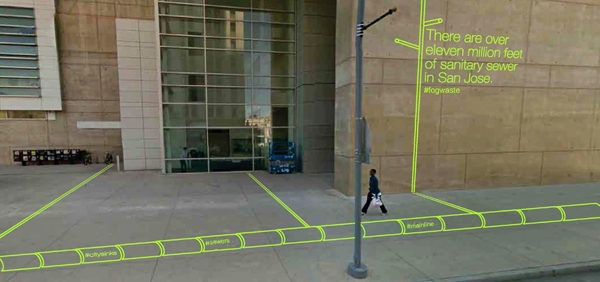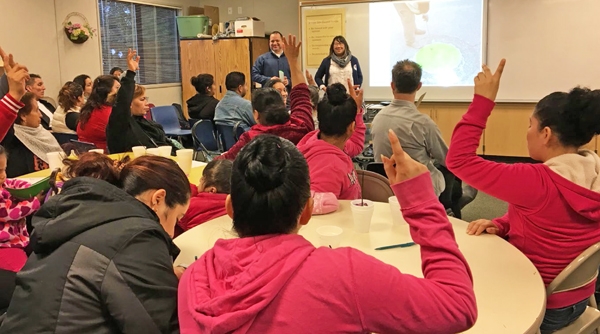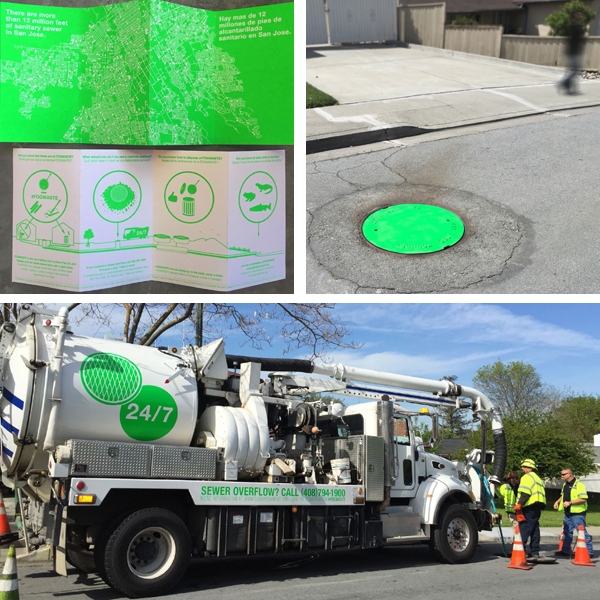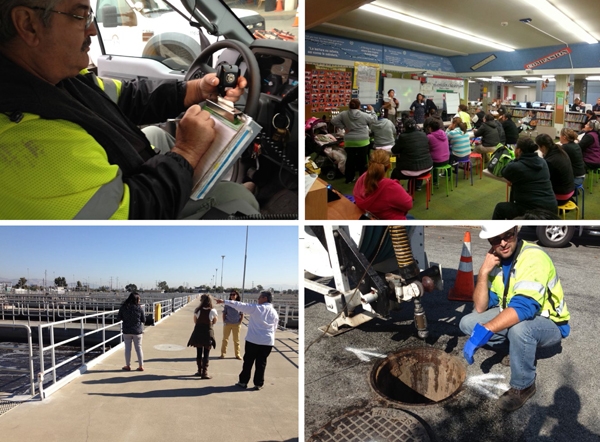For the majority of Californians, water appears effortlessly when and where you need it. It shows up in your faucet and flows out of your backyard hose with just the turn of a handle. And, it leaves just as predictably – rinsed down your kitchen sink drain, flushed down your toilet. However, the outgoing water is often full of things like fats, oils, and greases (also known as FOG waste) that can lead to problems in local sewer systems and beyond.
One of the biggest challenges in addressing FOG waste is rendering visible the largely invisible connection between household wastewater and city infrastructure. Claire Napawan, a landscape architect and urban designer in the Department of Human Ecology at UC Davis, and Brett Snyder, an architect and graphic designer in the Department of Design at UC Davis, were excited by the opportunity to develop an innovative public art installation to do just that.
Working with the City of San Jose as part of a unique collaboration between the city's environmental service and transportation departments, as well as its Public Art Program, Napawan and Snyder engaged with impacted communities to better understand how citizens deal with their kitchen waste in particular. Napawan says San Jose's initial request for proposals on dealing with FOG waste – titled “Public Art Project for Environmental Awareness of Sewer System Impacts” – was a shock. It asked for the exact kind of thing that she and Snyder do, which is work at the interface of design, infrastructure, and community participation.
“It was an amazing experience to see the city recognized the value of community engagement and human-centered design from the beginning. So often these calls ask for new technologies, and those often come with new problems. Instead, the city understood the opportunity to connect communities with their surrounding urban environments through participatory design.”
Napawan and Snyder took the participatory process seriously. Working with the city to identify FOG waste hot spots – places where the greatest number of FOG-related sewer overflows occurred – they found neighborhoods that also tended to be predominantly immigrant, low-income, or communities of color. They then worked with the city's Office of Cultural Affairs and local city council members to determine the best avenues to begin working with these communities. They honed in quickly on parent groups associated with local public schools. The groups were already set up to provide opportunities for community members to discuss concerns including education, health, and environmental stewardship.
From the beginning, the duo was clear they did not want their community engagement to focus directly on the problem, assigning blame, or instructing community members on best management practices. They also recognized that diving into the topic of fats, oils, and grease would not be the best way of engaging parents. Instead, they framed meetings with parent's groups as conversations on “kitchens, communities, and the city,” and invited participants to share a recipe during their first meeting. Napawan notes that the recipe share “opened the door to talking about the waste generated by these meals and how they are managed. Food became a great way to link the various concerns of the community with the sanitary sewer infrastructure.”
During the project, Napawan was pregnant with her second child, and conducted many of the early community workshops noticeably so, something that led to more connections within the community. She says, “It became a way I could relate with other mothers. After my son was born, I continued to lead workshops -- I would just bring him, pass him off to one of the mother's in the group, nurse during breaks, and have fantastic conversations about motherhood, as well as about FOG waste and sewers. It was such a rare and wonderful opportunity to feel like pregnancy and motherhood was helping me do my job.”
Based on what they learned during the participatory design process, Napawan and Snyder designed a suite of materials that connected household kitchen waste with sewer infrastructure. The materials included flashcards that provide reminders of the kinds of kitchen waste that contribute to the FOG problem, marked manhole covers on city streets, and related graphics on wastewater trucks. Together, the trio of bright green and integrated graphics served as a reminder of the connection between individual kitchens, city infrastructure, and the larger ecosystem of the San Francisco Bay Area.
In the design process, Napawan and Snyder developed valuable relationships with community members as they worked together over a three year period – those relationships continue today. They were also particularly proud of how supportive the sewer maintenance crew members were of the project. Napawan says “they also played a large role in the project's design and implementation. In a recent meeting with crew members, they shared with us how much they valued the project and how it enabled better communication with community members.”
Napawan and Snyder hope their work can provide an example for other municipalities to consider small-scale design interventions and community-based participatory approaches to urban environmental challenges.




